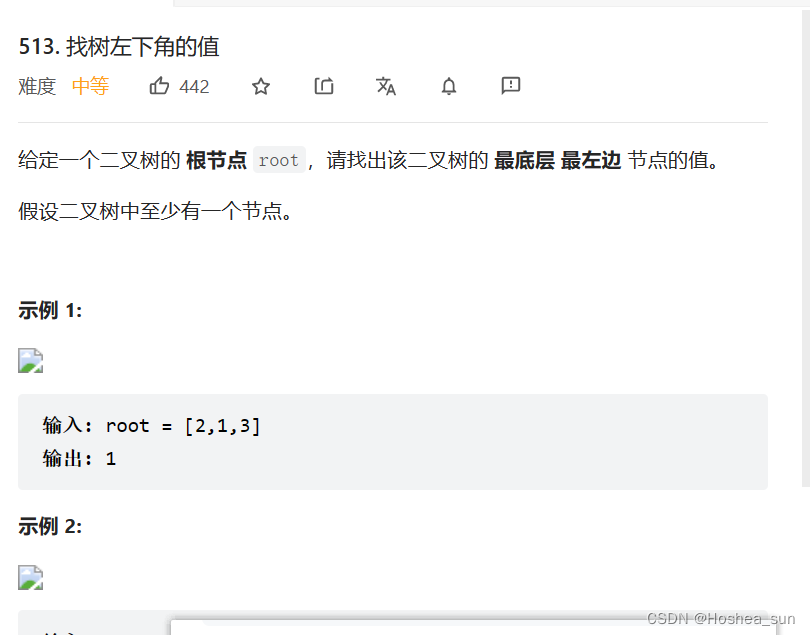层次遍历
使用 BFS 进行层次遍历。不需要使用两个队列来分别存储当前层的节点和下一层的节点,因为在开始遍历一层的节点时,当前队列中的节点数就是当前层的节点数,只要控制遍历这么多节点数,就能保证这次遍历的都是当前层的节点。
1. 一棵树每层节点的平均数

/**
* Definition for a binary tree node.
* public class TreeNode {
* int val;
* TreeNode left;
* TreeNode right;
* TreeNode() {}
* TreeNode(int val) { this.val = val; }
* TreeNode(int val, TreeNode left, TreeNode right) {
* this.val = val;
* this.left = left;
* this.right = right;
* }
* }
*/
class Solution {
public List<Double> averageOfLevels(TreeNode root) {
List<Double> ret = new ArrayList<>();//定义集合用来存储遍历到每层的节点的平均值。
if(root == null) return ret;
Queue<TreeNode> queue = new LinkedList<>();
queue.add(root);
while(!queue.isEmpty()){
int cnt = queue.size();//代表每一层的节点数
double sum = 0;
for(int i = 0; i < cnt; i++){
TreeNode node = queue.poll();
sum += node.val;
if(node.left != null) queue.add(node.left);
if(node.right != null) queue.add(node.right);
}
ret.add(sum / cnt);
}
return ret;
}
}队列、集合的使用。
2. 得到左下角的节点

/**
* Definition for a binary tree node.
* public class TreeNode {
* int val;
* TreeNode left;
* TreeNode right;
* TreeNode() {}
* TreeNode(int val) { this.val = val; }
* TreeNode(int val, TreeNode left, TreeNode right) {
* this.val = val;
* this.left = left;
* this.right = right;
* }
* }
*/
class Solution {
public int findBottomLeftValue(TreeNode root) {
//需要使用广度优先遍历
// if(root.left == null && root.right == null) return root;
//可以使用一个队列将节点存储
Queue<TreeNode> queue = new LinkedList<>();
queue.add(root);
while(!queue.isEmpty()){
root = queue.poll();//先加入右边,后加入左边。先谈出来的是右边。最后加入的就是最左边的节点。当停止循环的时候,最左边的节点被弹出来。得到答案。
if(root.right != null) queue.add(root.right);
if(root.left != null) queue.add(root.left);
}
return root.val;
}
}前中后序遍历
1
/ \
2 3
/ \ \
4 5 6
- 层次遍历顺序:[1 2 3 4 5 6]
- 前序遍历顺序:[1 2 4 5 3 6]
- 中序遍历顺序:[4 2 5 1 3 6]
- 后序遍历顺序:[4 5 2 6 3 1]
层次遍历使用 BFS 实现,利用的就是 BFS 一层一层遍历的特性;而前序、中序、后序遍历利用了 DFS 实现。
前序、中序、后序遍只是在对节点访问的顺序有一点不同,其它都相同。
① 前序
void dfs(TreeNode root) {
visit(root);
dfs(root.left);
dfs(root.right);
}
② 中序
void dfs(TreeNode root) {
dfs(root.left);
visit(root);
dfs(root.right);
}
③ 后序
void dfs(TreeNode root) {
dfs(root.left);
dfs(root.right);
visit(root);
}
1. 非递归实现二叉树的前序遍历
/**
* Definition for a binary tree node.
* public class TreeNode {
* int val;
* TreeNode left;
* TreeNode right;
* TreeNode() {}
* TreeNode(int val) { this.val = val; }
* TreeNode(int val, TreeNode left, TreeNode right) {
* this.val = val;
* this.left = left;
* this.right = right;
* }
* }
*/
class Solution {
public List<Integer> preorderTraversal(TreeNode root) {
//使用集合
List<Integer> ret = new ArrayList<>();
Stack<TreeNode> stack = new Stack<>();
stack.push(root);//根据栈先进后出的特性,前序遍历:中左右;
while(!stack.isEmpty()){
TreeNode node = stack.pop();
if(node == null) continue;//如果遍历的过程中,发现出现了null,也就是整个树遍历完成
ret.add(node.val);
if(node.right != null) stack.push(node.right);
if(node.left != null) stack.push(node.left);
//这两句话顺序一定不要搞混了,需要知道哪个先被放进栈中,栈是先进后出的。所以放进去的时候一定是先右后左。中间则是先被加入到集合中。
}
return ret;
}
}. 非递归实现二叉树的后序遍历
/**
* Definition for a binary tree node.
* public class TreeNode {
* int val;
* TreeNode left;
* TreeNode right;
* TreeNode() {}
* TreeNode(int val) { this.val = val; }
* TreeNode(int val, TreeNode left, TreeNode right) {
* this.val = val;
* this.left = left;
* this.right = right;
* }
* }
*/
class Solution {
public List<Integer> postorderTraversal(TreeNode root) {
List<Integer> ret = new ArrayList<>();
//栈,用来遍历
Stack<TreeNode> stack = new Stack<>();
stack.push(root);
while(!stack.isEmpty()){
//后序遍历的顺序是:左右中,所以入栈的顺序是,先右后左。直接将root最后添加到集合中即可
TreeNode node = stack.pop();
if(node == null) continue;
ret.add(node.val);
if(node.left != null) stack.push(node.left);
if(node.right != null) stack.push(node.right);
}
//最后进行一个集合的反转
Collections.reverse(ret);
return ret;
}
}Collections 类是 Java 提供的一个操作 Set、List 和 Map 等集合的工具类。Collections 类提供了许多操作集合的静态方法,借助这些静态方法可以实现集合元素的排序、查找替换和复制等操作。下面介绍 Collections 类中操作集合的常用方法。
排序(正向和逆向)
Collections 提供了如下方法用于对 List 集合元素进行排序。
- void reverse(List list):对指定 List 集合元素进行逆向排序。
- void shuffle(List list):对 List 集合元素进行随机排序(shuffle 方法模拟了“洗牌”动作)。
- void sort(List list):根据元素的自然顺序对指定 List 集合的元素按升序进行排序。
- void sort(List list, Comparator c):根据指定 Comparator 产生的顺序对 List 集合元素进行排序。
- void swap(List list, int i, int j):将指定 List 集合中的 i 处元素和 j 处元素进行交换。
- void rotate(List list, int distance):当 distance 为正数时,将 list 集合的后 distance 个元素“整体”移到前面;当 distance 为负数时,将 list 集合的前 distance 个元素“整体”移到后面。该方法不会改变集合的长度。
查找、替换操作
Collections 还提供了如下常用的用于查找、替换集合元素的方法。- int binarySearch(List list, Object key):使用二分搜索法搜索指定的 List 集合,以获得指定对象在 List 集合中的索引。如果要使该方法可以正常工作,则必须保证 List 中的元素已经处于有序状态。
- Object max(Collection coll):根据元素的自然顺序,返回给定集合中的最大元素。
- Object max(Collection coll, Comparator comp):根据 Comparator 指定的顺序,返回给定集合中的最大元素。
- Object min(Collection coll):根据元素的自然顺序,返回给定集合中的最小元素。
- Object min(Collection coll, Comparator comp):根据 Comparator 指定的顺序,返回给定集合中的最小元素。
- void fill(List list, Object obj):使用指定元素 obj 替换指定 List 集合中的所有元素。
- int frequency(Collection c, Object o):返回指定集合中指定元素的出现次数。
- int indexOfSubList(List source, List target):返回子 List 对象在父 List 对象中第一次出现的位置索引;如果父 List 中没有出现这样的子 List,则返回 -1。
- int lastIndexOfSubList(List source, List target):返回子 List 对象在父 List 对象中最后一次出现的位置索引;如果父 List 中没有岀现这样的子 List,则返回 -1。
- boolean replaceAll(List list, Object oldVal, Object newVal):使用一个新值 newVal 替换 List 对象的所有旧值 oldVal。
复制
Collections 类的 copy() 静态方法用于将指定集合中的所有元素复制到另一个集合中。执行 copy() 方法后,目标集合中每个已复制元素的索引将等同于源集合中该元素的索引。
copy() 方法的语法格式如下:void copy(List <? super T> dest,List<? extends T> src)其中,dest 表示目标集合对象,src 表示源集合对象。
注意:目标集合的长度至少和源集合的长度相同,如果目标集合的长度更长,则不影响目标集合中的其余元素。如果目标集合长度不够而无法包含整个源集合元素,程序将抛出 IndexOutOfBoundsException 异常。
3. 非递归实现二叉树的中序遍历
/**
* Definition for a binary tree node.
* public class TreeNode {
* int val;
* TreeNode left;
* TreeNode right;
* TreeNode() {}
* TreeNode(int val) { this.val = val; }
* TreeNode(int val, TreeNode left, TreeNode right) {
* this.val = val;
* this.left = left;
* this.right = right;
* }
* }
*/
class Solution {
public List<Integer> inorderTraversal(TreeNode root) {
//中序遍历的顺序是:前中后,所以这次不能用反转,或者直接添加的方法了。
List<Integer> ret = new ArrayList<>();
Stack<TreeNode> stack = new Stack<>();
if(root == null) return ret;
TreeNode cur = root;
while(cur != null || !stack.isEmpty()){
while(cur != null){
stack.push(cur);
cur = cur.left;
}
//出栈
TreeNode node = stack.pop();
ret.add(node.val);
cur = node.right;
}
return ret;
}
}BST
二叉查找树(BST):根节点大于等于左子树所有节点,小于等于右子树所有节点。
二叉查找树中序遍历有序。
1. 修剪二叉查找树
/**
* Definition for a binary tree node.
* public class TreeNode {
* int val;
* TreeNode left;
* TreeNode right;
* TreeNode() {}
* TreeNode(int val) { this.val = val; }
* TreeNode(int val, TreeNode left, TreeNode right) {
* this.val = val;
* this.left = left;
* this.right = right;
* }
* }
*/
class Solution {
public TreeNode trimBST(TreeNode root, int low, int high) {
if(root == null) return null;
if(root.val > high) return trimBST(root.left, low, high);
if(root.val < low) return trimBST(root.right, low, high);
root.left = trimBST(root.left, low, high);
root.right = trimBST(root.right,low, high);
return root;
}
}递归方法的巧妙运用,真的很巧妙。而且这种题目就是要用递归。总结出经验就可以了。就是要不断重复父节点做的事情。至于怎么处理还是结合具体的情况。
2. 寻找二叉查找树的第 k 个元素。。。
明天再看吧。涉及的内容挺多的,二叉搜索树的遍历方式,特点等等。























 被折叠的 条评论
为什么被折叠?
被折叠的 条评论
为什么被折叠?








